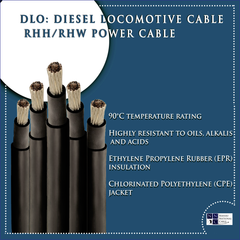¿Qué es un cable de locomotora diésel?
Un cable de locomotora diésel , también conocido como cable DLO , es un cable de alimentación portátil flexible de cobre estañado con aislamiento de caucho de etileno-propileno EPR y CPE y una cubierta exterior de polietileno clorado negro .
Una locomotora diésel, donde se utiliza este cable, es una locomotora ferroviaria que funciona con un motor diésel. Si bien el cable DLO toma su nombre de una locomotora de este tipo, puede utilizarse en otras máquinas con motores diésel, como aerogeneradores, maquinaria industrial, vagones de tren y muchas más. Su función principal es transmitir la potencia del generador al motor eléctrico.
Estos cables también se utilizan en conductores de motores, perforación petroquímica, minería y otras máquinas industriales. Estos conductores pueden funcionar en condiciones secas y húmedas a 90 °C.

Otras aplicaciones de DLO
- Como cable de construcción general.
- Para suministrar energía a los motores de tracción en vehículos ferroviarios y otras locomotoras diésel-eléctricas.
- En equipos terrestres y marítimos como por ejemplo para barcos, yacimientos petrolíferos, izajes, grúas, etc.
- En el cableado de vagones de tránsito, plataformas de perforación petroquímicas, equipos eléctricos de movimiento de tierras, suministro de energía para telecomunicaciones y suministro de energía en soldadura por arco.
- Para aplicaciones industriales de servicio pesado
¿Cómo se utiliza el cable DLO en parques eólicos?
El cable DLO es perfecto para proyectos eléctricos a gran escala en el entorno de parques eólicos, ya que es duradero y se adapta bien a entornos hostiles.
Información importante sobre NEC y la clasificación RHH/RHW-2
El nombre "cable para locomotora diésel" no se menciona en ninguna edición reciente del Código Eléctrico Nacional. Sin embargo, esto no significa que el cable DLO no esté aprobado. El cable DLO forma parte del artículo 310 del NEC, según su clasificación RHH/RHW-2 segundos.
En el Código Eléctrico Nacional, el cable RHH/RHW-2 es resistente al agua y con aislamiento de caucho, aprobado para enterramiento directo. Entonces, ¿qué diferencia a un cable DLO clasificado RHH/RHW-2 de un cable RHH/RHW-2 que no es DLO? El cable DLO posee propiedades especiales de flexión que evitan que los cables se dañen debido a su frecuente curvatura en muchas aplicaciones. Estas propiedades de flexión son una característica clave del cable DLO/RHH/RHW-2 de doble fila.
La ampacidad del cable DLO
La capacidad de corriente máxima del cable DLO, que se encuentra en el Código Eléctrico Nacional, se calcula con base en el cable DLO estándar con clasificación RHH/RHW-2. A continuación, se presenta la capacidad de corriente máxima admisible del cable DLO según NEC 2017 310.15(B)(17). La capacidad de corriente máxima se calcula para las versiones de cable de 75 °C y 90 °C.

Construcción de un cable DLO
Conductores
El conductor del cable DLO está fabricado con cobre estañado recocido de Clase I, con hilos de 24 AWG. El estaño se combina con el cobre para reducir la corrosión a largo plazo, mejorando la conductividad general de la fuente de alimentación y protegiéndola de la oxidación. El estaño es conocido principalmente por su protección contra la oxidación. No se corroe fácilmente en comparación con muchos otros metales, ya que protege el conductor de cobre bajo la capa de estaño.
Aislamiento
El material aislante de estos cables es de dos tipos: EPDM (monómero de etileno propileno dieno) y EPR (caucho de etileno propileno). Desde el punto de vista del rendimiento, la diferencia entre estos dos aislamientos es insuficiente. Utilizan diferentes tipos de polímeros que se curan con distintos elementos químicos.
Estos materiales son altamente flexibles y están compuestos por elementos de recubrimiento reticulados. Pueden torcerse y doblarse, como otros materiales aislantes, sin desgarrarse ni desgastarse. Esto mantiene al conductor seguro incluso en caso de incendio.
Chaqueta
La capa de revestimiento ayuda principalmente a identificar y clasificar el cable. El polietileno clorosulfonado, compuesto de material termoestable, tiene un revestimiento negro que recubre el conductor.
Orejetas
Las orejetas son conectores que se utilizan para conectar otros cables. El cable DLO se conecta a otro cable DLO para aumentar la transmisión de potencia. Las orejetas están hechas de cobre puro estañado y tienen extremos acampanados con cámaras de entrada.
NNC ofrece un cable RHH/RHW-2 DLO de 2 kV con clasificación adecuada que cumple con todas las especificaciones esperadas.




















